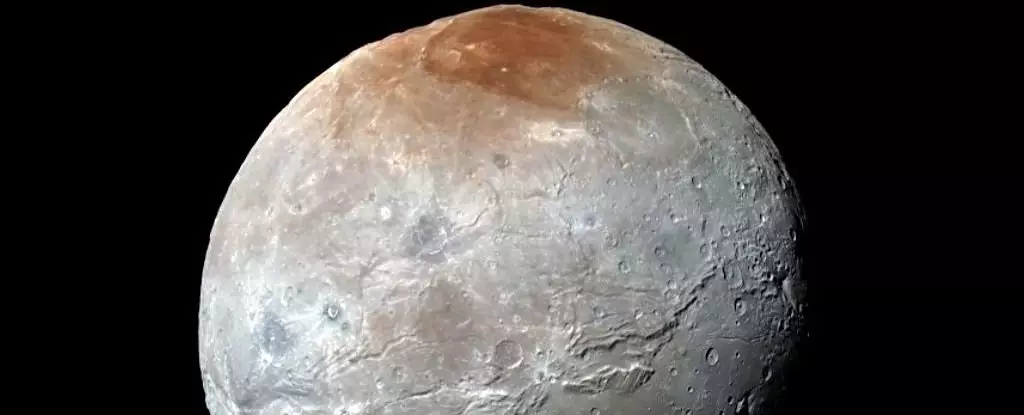Nestled in the distant fringes of our Solar System, roughly 5.7 billion kilometers from the warmth of the Sun, the dwarf planet Pluto presents a compelling world characterized by its icy surfaces and intriguing features. Smaller than Australia, Pluto may seem insignificant compared to celestial giants, but its complex moon system, particularly Charon, invites fascination and inquiry. While Pluto itself boasts breathtaking landscapes of mountains, glaciers, and craters alongside frigid average temperatures plummeting to -232°C, Charon emerges as a focal point of interest, being Pluto’s most prominent moon among its five companions: Styx, Nix, Kerberos, Hydra, and Charon. This article explores recent scientific revelations about Charon and its implications for understanding our Solar System’s far-reaching corners.
One of the most distinctive features of the Pluto-Charon relationship is their classification as a binary system. In contrast to well-known planetary systems where one body orbits another—like Earth and its Moon—Pluto and Charon engage in a complex gravitational dance, revolving around a mutual barycenter. This unique arrangement raises fundamental questions about the nature of their formation and contributes to Pluto’s reclassification from planet to dwarf planet. The reclassification stems primarily from the orbiting duo’s inability to dominate their gravitational zone, failing to meet one of the criteria established by the International Astronomical Union (IAU) for full planetary status.
Recent findings from the advanced James Webb Space Telescope (JWST) have unveiled intriguing chemical constituents on Charon’s surface, including carbon dioxide and hydrogen peroxide. This groundbreaking discovery, detailed in a publication within *Nature Communications*, is pivotal for deciphering the moon’s geological history. Prior observations indicated that Charon is abundant in water ice, but the presence of carbon dioxide suggests dynamic geological processes may be at play beneath its frozen exterior.
The JWST utilizes sophisticated infrared spectroscopy to unveil the identity of various molecules, acting like a cosmic fingerprint reader. Each molecule emits a unique spectral signature that allows scientists to infer its existence and concentration on celestial bodies. Such analysis can interpret the moon’s evolutionary narrative and highlight its interactions with the extraterrestrial environment, including potential impacts from asteroids that may have exposed subsurface materials.
Another captivating aspect of Charon’s landscape is the presence of cryovolcanoes—areas that expel icy materials rather than molten rock. This phenomenon challenges traditional thoughts on volcanism and invites speculation about the geological processes operating on celestial bodies far removed from the Sun’s warmth. Understanding the composition and geological activity of Charon not only enhances our grasp of its own history but provides context for other trans-Neptunian objects (TNOs).
The origins of Charon remain an enigma, with several theories vying for attention. Currently, one of the leading hypotheses postulates that Charon formed from a colossal impact similar to Earth’s Moon. This scenario suggests that a massive body collided with Pluto over 4.5 billion years ago, breaking off a section that eventually solidified into Charon. Alternatively, it is possible that both entities formed separately and subsequently entered a gravitational embrace.
By unraveling Charon’s compositional secrets, scientists can better understand not only its genesis but also similar bodies in the distant reaches of our solar neighborhood. The clarification of these evolutionary pathways provides a broader framework for understanding the complexities of planetary formation and the evolution of our solar system at large.
As scientists continue to analyze data from the James Webb Space Telescope and await future explorations, the implications of the latest discoveries expand beyond Charon. The behaviors and compositions of distant moons and dwarf planets inform our knowledge of planetary science and the conditions that foster celestial diversity. Each piece of data collected inches us closer to a holistic understanding of the fascinating worlds that lie hidden in the dark recesses of space, waiting to be illuminated by the inquiries of human curiosity.
Charon, with its peculiar duality alongside Pluto and newfound chemical compositions, serves as a gateway to understanding the vast intricate tapestry of our solar system. The dual discoveries of carbon dioxide and hydrogen peroxide open avenues for exploration and invite further appreciation of the celestial bodies that govern the realms beyond Neptune. As we continue our quest for knowledge, Pluto and its enigmatic moon remain critical components of the conversation about our place in the cosmos, ensuring our fascination with these distant worlds endures.


Leave a Reply